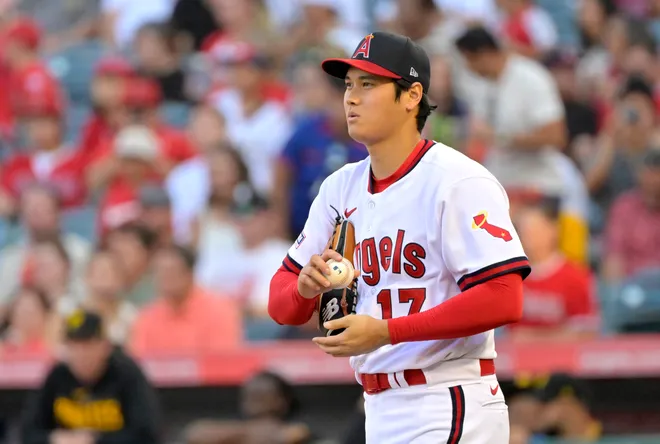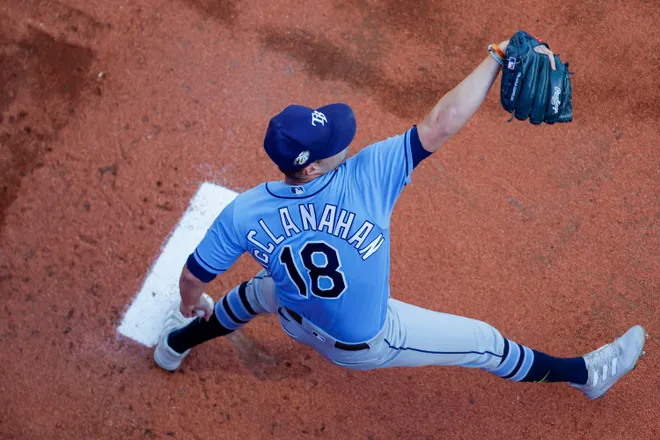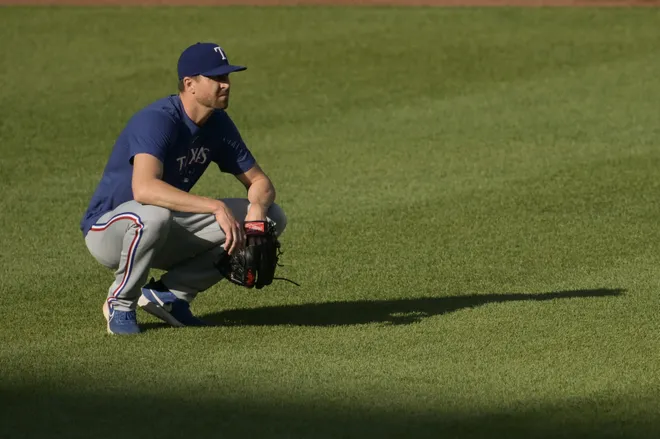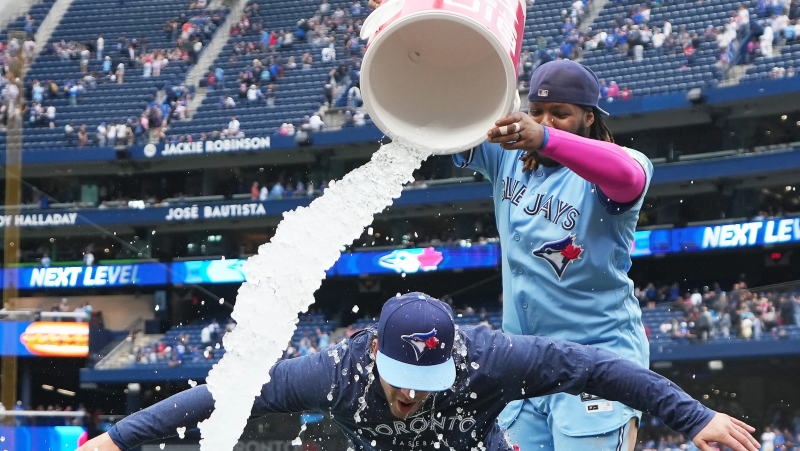Velocity at what cost? MLB's hardest throwers keep succumbing to Tommy John surgery
The road to a 100 mph fastball is littered with ruptured ulnar collateral ligaments. And it’s also a significantly dangerous destination upon arrival for Major League Baseball’s top flamethrowers.
So much remains unknown about pitcher health – why some get hurt, while others enjoy decades of incident-free hard throwing – and through countless studies, trials and one 384-page bible on the subject, best practices have emerged but not definitive answers.
Yet it’s hard to ignore a correlation between extremely hard throwers and major elbow injuries. This year’s velocity kings bear the evidence.
Of the top 64 hardest throwers this season based on average fastball velocity calculated by Statcast, 30 – nearly half – have undergone reconstructive Tommy John surgery on their pitching elbows or are expected to undergo the procedure soon, according to USA TODAY Sports research.
That population is headlined by two pitchers at the bottom of this ultra-velocity club – Los Angeles Angels two-way superstar Shohei Ohtani and Tampa Bay Rays ace Shane McClanahan, who each averaged 96.8 mph with their fastballs this season and recently blew out their UCLs a second time.
FOLLOW THE MONEY: MLB player salaries and payrolls for every major league team
McClanahan became the eighth Rays pitcher to undergo Tommy John surgery since 2020 and the third member of their rotation to suffer a season-ending elbow injury, though at 81-52, they retain the second-best record in the American League.
Ohtani is mulling whether to undergo a second procedure - he suffered his first UCL failure in 2018 - and has continued to serve as the Los Angeles Angels’ designated hitter, with hundreds of millions of dollars in free agency at stake this winter.
While Ohtani’s Angels had faded from serious playoff contentions before he walked off the mound in pain Aug. 23, the postseason will be greatly affected by hard throwers shelved by a failed elbow.

Baltimore Orioles closer Felix Bautista, who averaged 99.5 mph on his fastball and struck out 110 in 61 innings, exited Friday’s game one strike away from his 34th save. The Orioles announced Saturday he has a UCL injury but have not revealed if surgery will be required.
And like McClanahan, two-time Cy Young Award winner Jacob deGrom – who gassed his fastball up to 98.7 mph in this, the first year of a $185 million deal with Texas – underwent his second elbow reconstruction procedure in June.
These high-profile, debilitating injuries, while representing a small sample, have nonetheless mirrored the frustrations of orthopedists and biomechanical experts who have seen reconstructive surgeries rise along with fastball velocity as pitchers young and old are convinced big velo is the overriding factor in getting scouted, signed and paid.
“It’s very frustrating to me and my colleagues,” says Dr. Glenn Fleisig, biomechanics research director at the pioneering American Sports Medicine Institute in Birmingham. “Frankly, the number of Tommy John injuries in minor league and major league baseball continues to rise.
“If you chart the rates of Tommy John injuries compared to the average fastball velocity, it’s scary how the graphs look the same.”
The average fastball velocity in MLB increased from 90.5 in 2008 to 93.9 in 2022. And from 2016 to 2022, the number of pitches registering 100 mph leaped 72%, from 1,948 to 3,356.
It used to be that pitchers would go as hard as they can as long as they can – as in, innings in a given start. Now, length too often is measured in how long their elbow survives, leaving teams to reap the benefits in the short term but ultimately ponder a phrase more often associated with football.
Next man up.
“It’s astronomical,” Stan Conte, a senior medical director for the Miami Marlins and consultant to MLB, told USA TODAY Sports. “Part of the reason is because the damn surgery works. In MLB, 84% get back to their previous performance. Ninety percent get back to pitching competitively.
“To me, it’s funny guys aren’t afraid of Tommy John surgery. The question is, what’s causing it?”
'To get to the next level, you gotta throw 97-99'
To Conte, a longtime trainer for the Giants and Dodgers who also operates a sports performance clinic in Arizona, it is not purely the quest for velocity. Advances made in weight- and weighted-ball training have cleared a path to an upper-90s fastball that may supplant or enhance the natural ability gifted in a pitcher’s arm.
Certainly, there are safe ways to build velocity, and hundreds of professional pitchers have healthy elbows and mid-90s fastballs to show for it.
Yet the failure of baseball’s most important ligament is a multi-factorial puzzle, with mechanics and fatigue likely the most crucial – and potentially compromised by throwing hard.
A survey Conte conducted of more than 6,000 major- and minor league players in 2012 revealed that 13% of minor league pitchers had undergone Tommy John surgery in either their amateur or pro careers. By 2018, a similar survey revealed that the percentage of minor league pitchers who had Tommy John soared to 19%; 26% of major league pitchers had undergone the reconstructive surgery.
Nowadays, the chase for velocity begins not on a spring training backfield or minor league complex but at a private training facility or college campus, the pitcher likely still in their teens.
That creates a significant variance in quality of instruction compared to the caliber an athlete might enjoy at the game’s highest level.
“Nobody is really teaching good mechanics,” says Conte. “What they’re saying in college is, you want to get to the next level, you gotta throw 97-99. It doesn’t matter if you hit the bull or can’t throw a strike.”
Of our 30 pitchers with reconstructed or compromised UCLs atop the Statcast velocity leaderboard, 16 underwent Tommy John surgery either as amateurs or in Class A or lower professional ball, according to statistical analyst Joe Roegele’s database.
McClanahan, Marlins starter Jesús Luzardo and Rays reliever Pete Fairbanks each had surgery in high school, with Fairbanks going under the knife again in A ball. Trevor Megill, Spencer Strider and Jeff Hoffman had surgery in college, while Fairbanks and 10 others had elbow reconstruction before even surviving the Darwinist world of the low minors.
Just two suffered injuries in AA or AAA ball, with the rest at the major league level.

Load management
Grayson Rodriguez’s locker is just a few stalls down from All-Star closer Bautista in the Baltimore Orioles’ clubhouse, the positioning a cruel reminder of the vagaries of elbow health. The Orioles are bound for the playoffs, but while Rodriguez is pitching his way into the postseason rotation as a rookie, Bautista likely will miss the proceedings.
Even if he avoids surgery, Bautista probably won’t have an onramp to rest and rehab the injury. At 99.5 mph, Bautista threw the sixth-hardest fastball in the majors this year, and in a memorable nine-pitch battle with Houston’s Kyle Tucker that culminated in a grand slam on Aug. 8, Bautista threw six pitches that exceeded 100 mph, topping out at 102.
As a starting pitcher, Rodriguez doesn’t quite live in that rent district; his fastball tops out at 97.4 mph, 40th on the list but fifth among starters. What makes him special is hitting 98.4 mph on his 93rd pitch, as he did Monday in the greatest start of his young career, throwing six shutout innings against the Chicago White Sox.
Perhaps more notably, Rodriguez, 23, has survived the crucible of amateur ball and the minor leagues without major injury, an outcome for which he credits his parents – who watched his pitch counts and usage warily as a youth – and the Orioles for handling his workload as a pro.
“I was very fortunate my parents cared a lot about my health when I was younger, and really just being adamant about if I’d thrown too many pitches, or hadn’t had enough rest,” says Rodriguez, who recounts games of long toss with his father on their Texas street, a young Rodriguez envisioning the day he’d someday reach a certain light pole from his driveway.
“This organization does a really good job managing pitcher workloads. I think they really have our health in mind.”
Rodriguez, a true horse at 6-5, 230 pounds, works out with weighted balls to improve velocity, but only in the offseason to avoid further strain during the year. In a sense, Rodriguez represents the potentially modern ideal of a pitcher – one who can throw 100 mph, repeat his mechanics, leverage his natural ability but enhance his velocity.
And hold it for 100 pitches.
Veteran pitcher Michael Lorenzen says he believes the future will bring a generation of “guys sitting 99 (mph) and throwing 210 innings.” Yet he, too, believes the radar gun is a modern ill, forcing pitchers to compromise their health when the readings are suboptimal.
“Back in the day, guys like Nolan Ryan, if they didn’t feel great that day, could throw 87 mph and just say, ‘I didn’t have my best fastball that day,” says Lorenzen, 31, an All-Star this season. “But if I were to go out there and throw seven fastballs at 88 mph, the trainers would be out on the mound.
“So what does that do in my mind? If I have 88 mph in the tank, to me that tells me I have to throw 95. Say I throw 50 fastballs at 95 when I should be throwing 88 because my body doesn’t feel great, it’s all because I don’t want to spark any red flags. It’s extremely compromising on the body.
“So what do you do? You say, ‘I need to be up at 95. I have more in the tank.’ So you’re fatigued, you do it again, you do it enough times, you’re going to go down.”

Speed vs. safety
Indeed, in an ideal setting, Conte says three elements are working to protect the UCL, each bearing roughly equal responsibility: The bones (ulna, radius, humerus), the flexor tendon and the ligament itself.
Fatigue can compromise the flexor tendon, which is why a flexor strain sets off red flags and, in some cases, be a precursor to a torn UCL.
Maximum velocity does not help the cause, either.
Fleisig helped conduct a 2019 study on fastball velocity and torque on the elbow. While it did not find that harder throwers placed greater torque on their elbows than softer tossers, it did conclude that “within-subjects analyses suggested a deliberate reduction in velocity will reduce the load on an individual pitcher’s elbow.”
For practical purposes, Conte points to Marlins right-hander and reigning Cy Young Award winner Sandy Alcantara as the gold standard for varying velocity. Alcantara’s fastball ranks 30th in average velocity, at 97.9 mph, although his sinking fastball can touch 101 mph.
More important, his four-pitch mix lessens the importance on what Conte calls the most dangerous pitch for a hurler: The maximum-effort fastball.
Alcantara is closing in on his fourth consecutive full season of making at least 30 starts and pitching at least 197 innings. That makes him a rarity during a period Conte said was MLB's most tumultuous period of injuries - with more than 800 players going on the injured list in 2022.
A literal arms race
The fight to curtail lost years due to elbow failures is happening on two fronts.
First is repair. It will soon be five years since Dallas-based orthopedist Keith Meister began using an extra-large tightening suture on Tommy John repairs, hoping to result in a stronger graft that can better withstand the stress of a 100-mph fastball. Orthopedist Jeffrey Dugas, one of Fleisig’s co-authors on elbow torque research, pioneered the internal brace procedure that has become increasingly popular for two-time Tommy John patients, in part because it offers a potentially shorter recovery time than the standard 18 months for a starting pitcher.
And the second is prevention. The biomechanics space is growing more crowded and in an effort to share information and unify best practices, the American Baseball Biomechanics Society was born in 2020. While proprietary information remains the artillery of modern warfare in baseball – and injury prevention is no different – Fleisig says the group aims to leverage technology and information to the greater good of the industry.
Beyond that, the injury prevention space is not holding its collective breath awaiting a paradigm shift. Velocity – the quest for it, its deployment to get outs and get paid – won’t be diminishing anytime soon.
Only the industry can decide how many injuries are too much, and whether availability, still, is the best ability.
“I think as the word gets out there, as the mindset changes, I’m hopeful there will be a shift in what teams are looking for and therefore what players are trying to do to move forward,” says Fleisig. “Every team wants to be the World Series champion. To do that, they need pitchers who are excellent and stay healthy.
“You’re not excellent if you’re here rehabbing in Birmingham.”

Disclaimer: The copyright of this article belongs to the original author. Reposting this article is solely for the purpose of information dissemination and does not constitute any investment advice. If there is any infringement, please contact us immediately. We will make corrections or deletions as necessary. Thank you.







